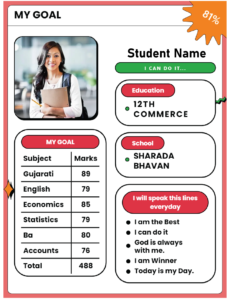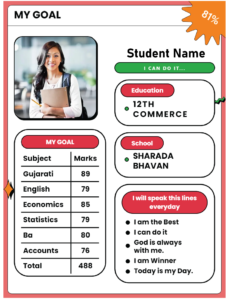Student Goal – Form Examples of 10 educational goals
નમસ્કાર 🙏🏻 Student Goal
શિક્ષણપ્રેમી શિક્ષક મિત્રો 🧑🏻🏫
બોર્ડની પરીક્ષાને જ્યારે 1 દિવસની વાર છે. ત્યારે
ધોરણ 10 અને 12 ના વિદ્યાર્થીઓ માટે ગોલચાટૅ બનાવવા આવ્યો છે જે વિદ્યાર્થીઓને પ્રેરણા અને હિંમત પુરી પાડશે.
ઉપરના ફોર્મ ની વિગતો ભરીને તમે પણ તમારો ગોલચાટૅ મેળવી શકો છો.
વધુમાં વધુ વિદ્યાર્થીઓને આ લિંક મોકલી એમને ગોલ પુણૅ કરવા માટે ભાગીદાર બનીએ.
શુભ મંગલ
વિજય ભવ:
🥳🏆🎯🥇☺️🕺🏻🌻

આવું ફોર્મ બનાવવા અહીં ક્લિક કરો
https://demo.rnwmultimedia.com/school_data/student_card.php
Click here to create such a form
https://demo.rnwmultimedia.com/school_data/index.php
नमस्कार 🙏🏻
शिक्षा प्रेमी शिक्षक मित्रों 🧑🏻🏫
बोर्ड परीक्षा की अवधि 1 दिन है. तब
गोलचट्टा कक्षा 10 और 12 के छात्रों के लिए बनाया गया है जो छात्रों को प्रेरणा और साहस प्रदान करेगा।
आप उपरोक्त फॉर्म विवरण भरकर भी अपना गोलचट्टा प्राप्त कर सकते हैं।
आइए इस लिंक को अधिक से अधिक छात्रों तक भेजकर इस लक्ष्य को प्राप्त करने में भागीदार बनें।
शुभ मंगलवार
विजय भव:
🥳🏆🎯🥇☺️🕺🏻🌻
Greetings 🙏🏻
Education loving teacher friends 🧑🏻🏫
Board exam duration is 1 day. then
Golchata is created for the students of class 10 and 12 which will provide inspiration and courage to the students.
You can also get your Golchata by filling the above form details.
Let’s partner to achieve this goal by sending this link to as many students as possible.
Good Tuesday
Vijay Bhava:
🥳🏆🎯🥇☺️🕺🏻🌻

The Student Goal Setting Form is a form template designed to help teachers, educators or school administrators set academic, personal or behavioral goals for their students. This form encourages students to play an active role in their own learning and development. By providing a structured platform for goal setting, teachers can track student progress and provide necessary support and guidance. This form enables teachers to establish clear objectives and helps students stay focused and motivated.
With JotForm’s Form Builder and JotForm Tables, creating and managing student goal setting forms becomes easy. A user-friendly, drag-and-drop form builder allows teachers to customize forms to their specific needs. They can easily add fields, set up conditional logic and personalize the design. JotForm Tables, a spreadsheet-style workspace, provides a central location for organizing and analyzing form data. Teachers can visualize, filter and sort data to gain insights into student progress. JotForm’s ease of use and customization options make it an ideal solution for educators looking to increase goal setting and student engagement.
Term Rostered: List of terms in the current and previous academic years in which students, instructors, and classes are rostered in your district. For example, an instructor can view a student’s test results from a previous term when the student was in another class. The default setting is the current term.
School, Instructor, Class, and Student: The choices you have depend on your MAP role. The Assessment Coordinator can choose from across the district-wide. Other roles are limited to assigned schools and classes.
Growth Comparison Period: Sets the initial and final testing terms for measuring growth shown in the “Growth Measured from” period on the report. Default selection depends on the roster term selected rather than current term. For example, if the term rostered begins in the fall or winter, the default growth comparison period is fall to spring in the same academic year. If the term rostered begins in spring, the default growth comparison period is spring to spring for the same academic year.
Subject: List of subjects you can show on the report.
Download Student Goal Setting Worksheet Template: Link to a blank Student Goal Setting Worksheet you can use to set goals and action plans for any student.
Examples of 10 educational goals
Education goals put into words what you’d like to achieve after a certain amount of time, such as after completing a course or a program. It explains the skills, competencies and qualities you hope to possess by that time.This process usually involves identifying objectives, choosing attainable short-term goals and then creating a plan for achieving those goals. Here are 10 examples:
1. Think positive to stay focused
Positive thinking can make it easier for you to focus on tasks that need to be done and learn new information. For instance, if you approach learning better writing skills with a positive mindset, you may be more likely to stay focused since you’re open to the experience.To maintain a positive mindset toward learning, here are a few things you can do:
- Set and track your own learning goals
- Manage your stress
- Be open to new ideas and approaches
- Visualize a positive outcome
- Learn from your mistakes
2. Stay resilient
Resiliency refers to the ability to adapt after encountering a challenge. It’s important to acknowledge the challenge or difficulty in order to find a way to overcome it. Resiliency helps you accept the issue and find steps to move past it while staying positive.Here are a few ways to improve your resiliency:
- Find a sense of purpose in your life
- Establish positive beliefs in your abilities
- Build a strong network
- Embrace change
- Develop your problem-solving skills
3. Make time to read
Reading can help you to develop critical thinking skills, which are important to make well-reasoned decisions. Reading requires you to think and process information in ways you may not experience in other forms of entertainment. You can read fiction, autobiographies or journals on any topic that interests you. While you read, take notes to keep your mind focused on the text.Here are a few tips that can help you make time to read every single day:
- Read first thing in the morning or before bed
- Always keep a magazine, newspaper or book in your bag in your bag
- Use bus or subway time to catch up on reading
- Find material that you find interesting
- Set reminders for reading
4. Manage your time
Good time-management skills help you to prioritize tasks so you’re able to complete work and assignments on time. You should also plan ahead, set aside the time you need for assignments and projects and stay focused to better use that time.Here are some tips to effectively manage your time and improve your study:
- Create a daily, weekly and monthly schedule
- Avoid distractions while you’re studying
- Set goals for every study session
- Start working on projects or tasks early
- Make a project plan
- Work on one task at a time
- Start early in the day
5. Find time to relax
Finding time to relax can help you to stay focused and motivated. Giving yourself time to do something you enjoy or practice self-care can help instill balance in your life. When you take a break, you can usually return to your task with a renewed focus and a fresh perspective.Here are a few ways you can relax:
- Get quality rest
- Practice the 50/10 rule (50 minutes of work followed by a 10-minute break)
- Plan your meals a week in advance
- Schedule time for your hobbies and interests
- Take breaks during difficult projects
6. Strive for excellence
You should strive for excellence in your work by setting and then exceeding goals. Excellence is about striving to be better, with the end goal of providing consistent quality work. To achieve excellence in your day to day, you need to spend time practicing and developing new skills.Here are a few tips to develop the habit of excellence:
- Explore new ideas
- Do more than what’s expected of you
- Take risks
- Surround yourself with positive people
- Build a trusted connection with a mentor
7. Build a strong network
Networking is about building and nurturing long-term relationships with the people you meet. When you invest time in building meaningful relationships (personal and professional) you create a network of people you can rely on throughout your career.Networking allows you to develop and improve your skill set, while staying up-to-date about the job market, meeting prospective mentors and gaining access to resources that can promote your development.Here are a few tips to build a strong network:
- Take the first step by reaching out
- Listen to advice and tips
- Treat people with dignity and respect
- Learn to trust more
- Give and take constructive feedback
- Have empathy
8. Build good study habits
One of the most important parts of academic success is practicing good study habits. Developing and maintaining good study habits can help you to increase your competence, confidence and self-esteem.Good study habits can also help to reduce your anxiety about deadlines and/or tests. You may also be able to reduce the number of hours that you spend studying, leaving more time for other important things in your life.Here are a few steps you can take to build good study habits:
- Plan when you are going to study
- Create a consistent, daily study routine
- Set a study session goal to help achieve your overall academic goal
- Avoid procrastination
- Create an environment conducive to studying
- Spread material throughout several study sessions
9. Attend seminars or training
A seminar is an expert-led educational meeting that focuses on a specific topic or discipline. Seminars are an ideal opportunity for you to study a topic in-depth. By asking questions, paying attention to the speaker and writing notes, you can leave a seminar with a wide range of knowledge in a specific field.Along with having access to experts, seminars also allow you to meet other people who share your interests and build connections. Seminar discussions give you an opportunity to debate issues related to the field, exchange ideas and share experiences. Meeting new people can offer solutions to common problems, encouragement and advice for how to handle challenges.Related: What Is On-the-Job Training?
10. Develop patience to achieve your goals
Being patient can help you realize that consistent reflection and hard work can produce successful outcomes. Many goals you need to reach often take time and patience can help you continually produce excellent work.Here are a few tips to overcome impatience:
- Be more mindful of your thoughts and reactions to what is going on around you
- Calm your mind so that you can think more clearly about your situation
- Practice deep breathing and mindfulness techniques
- Set milestones and reward yourself when you reach them
TAGGED: –
- 2024
- onedaynews
- newnews
- oneplus nord 5 launch date in india specifications
- India vs England
- Ravichandran Ashwin
- Ashwin collected his special 100th cap
- Ashwin
- Xiaomi 14 Ultra launched in India price in india
- Student Goal
-



